Physical Address
304 North Cardinal St.
Dorchester Center, MA 02124
Physical Address
304 North Cardinal St.
Dorchester Center, MA 02124
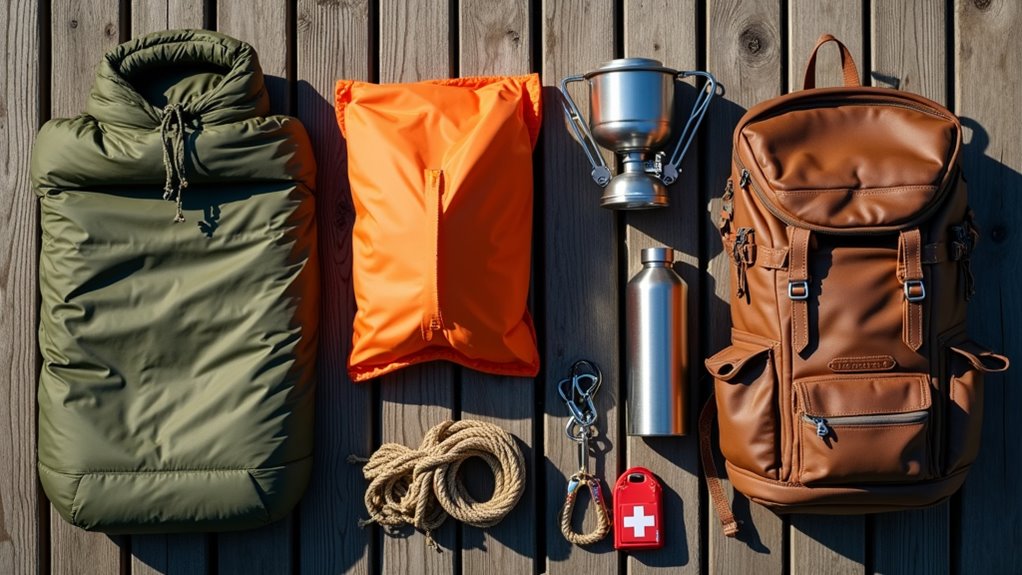
Get essential camping gear recommendations that maximize comfort without breaking your budget, but discover which expensive items you should completely avoid.
When you’re planning your next camping adventure, you’ll quickly realize that the right gear can make or break your experience. You don’t need to spend a fortune on every high-end gadget, but certain supplies are absolutely worth your investment. Smart choices in shelter, cooking equipment, and safety gear will keep you comfortable without emptying your wallet. The key lies in knowing which items truly matter and which ones you can skip or improvise.
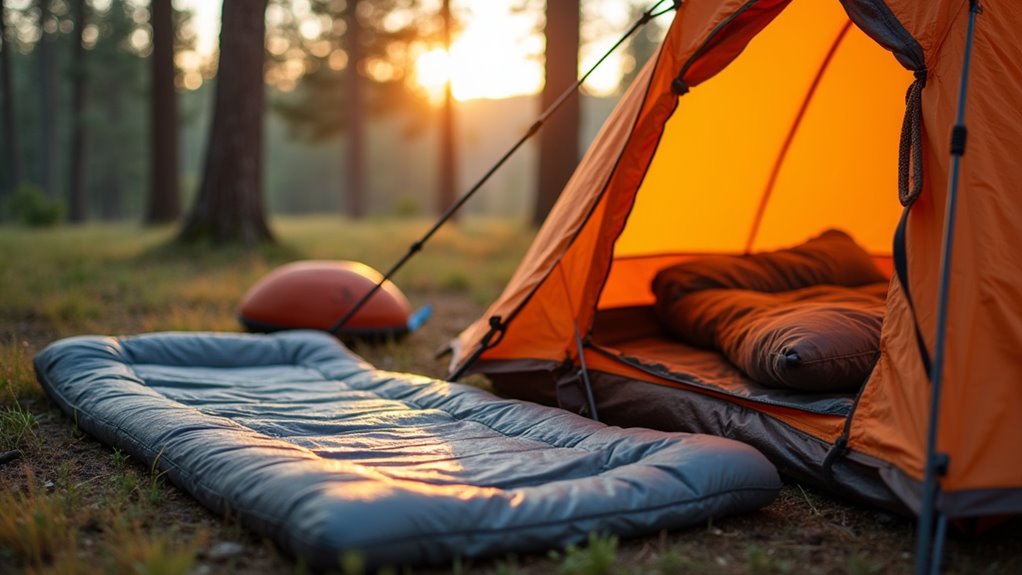
A good night’s sleep can make or break your camping trip, and it all starts with choosing the right shelter and sleep system for your needs and budget. Your tent doesn’t need to be expensive—just weatherproof and appropriately sized. Look for deals on last season’s models or consider reliable budget brands.
Don’t skimp on your sleeping pad; it’s essential for insulation and comfort. Closed-cell foam pads cost less but aren’t as comfortable as inflatable ones. Your sleeping bag should match expected temperatures—synthetic fill costs less than down but performs when wet.
Test everything at home first. Set up your tent in the backyard and sleep in your bag indoors. You’ll discover any issues before you’re miles from civilization.
Stay updated on the latest trends in camping gear to discover innovative materials and designs that could enhance your outdoor sleeping experience.
While fancy camp kitchens look impressive, you’ll cook great meals with basic, reliable gear that won’t drain your wallet. Focus on multipurpose items that pack efficiently and handle real camping conditions.
Your essential cooking kit should include:
Don’t overthink food storage. Hard-sided containers prevent crushing, while soft coolers work fine for day trips. Pack non-perishables in sealed bags, and you’ll eat well without breaking your budget.
For jungle camping adventures, consider bringing a hammock setup instead of traditional ground tents to keep your sleeping area elevated above moisture and wildlife.
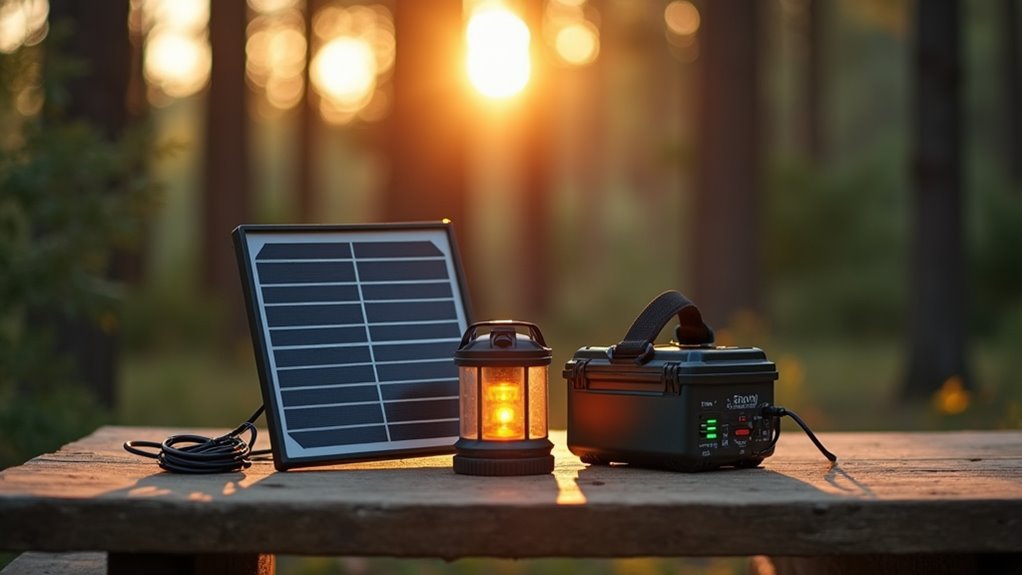
Good food keeps you fueled, but reliable lighting keeps you safe and functional after sunset. You’ll need multiple light sources since batteries die and bulbs break. Pack a headlamp as your primary light—it keeps your hands free for cooking, setting up camp, or reading maps. Bring a backup flashlight and extra batteries for both.
Lanterns work great for lighting your entire campsite. Battery-powered LED lanterns are reliable and bright, while solar lanterns charge during the day without extra cost.
For power needs, portable battery banks keep your phone and GPS charged. Solar chargers work well for extended trips, though they’re weather-dependent. Consider a hand-crank radio for emergencies—it doesn’t need external power and provides weather updates. Look for cutting-edge camping gear that combines multiple functions, like lanterns with built-in phone charging capabilities.
Even with the best planning, nature can throw unexpected challenges your way, making navigation and safety gear essential for any camping trip. You don’t need expensive gadgets to stay safe and oriented in the wilderness.
Start with these budget-friendly essentials:
These items won’t break your budget but could save your life. Practice using your compass and map before heading out, and always tell someone your planned route and return time. If you’re bringing your furry companion along, remember that camping with dogs requires additional safety considerations to ensure both you and your pet stay protected in the wilderness.
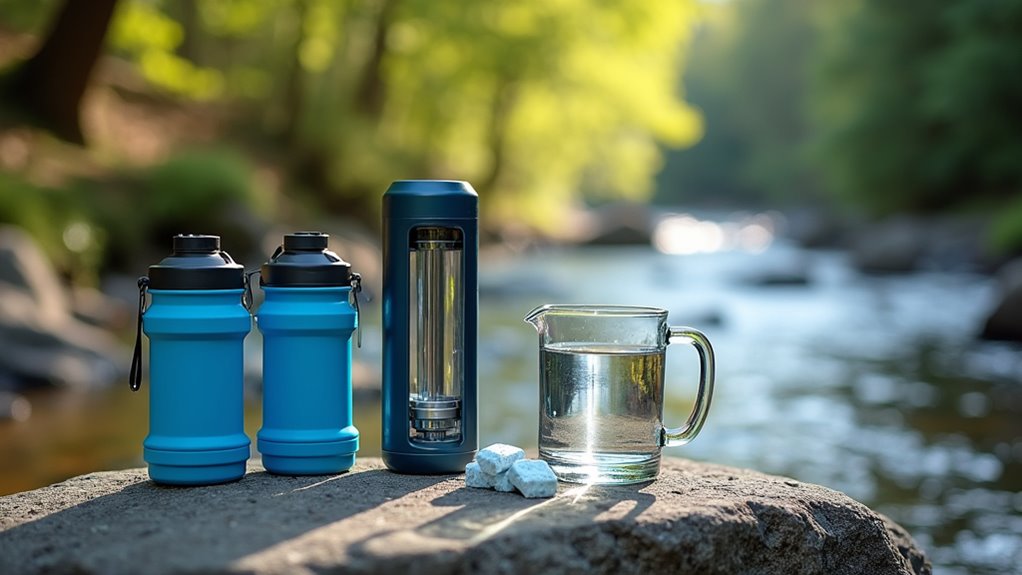
Clean drinking water ranks as your most critical camping need, yet it’s often overlooked until you’re staring at a questionable creek wondering if that upstream beaver is your biggest concern. You’ll need reliable filtration that won’t break your budget or your back.
Don’t let sketchy water sources turn your wilderness adventure into a survival nightmare you’ll never forget.
Portable water filters like LifeStraw or Sawyer Mini offer excellent bang for your buck, removing bacteria and parasites from natural sources. For group camping, consider gravity-fed systems that filter larger quantities hands-free.
Water purification tablets serve as lightweight backup options, though they leave an aftertaste.
Don’t forget hydration systems. Collapsible water bottles save pack space, while insulated bottles keep drinks cold longer. Hydration bladders integrate seamlessly with backpacks for easy access during hikes.
Always carry more capacity than you think you’ll need. When planning water filtration for extended wilderness adventures, having both primary and backup purification methods becomes absolutely essential for safety.
After securing your water needs, you’ll want tools that earn their weight in your pack by handling multiple jobs around camp. Multi-purpose tools are budget-friendly workhorses that’ll save space and money while keeping you prepared for various situations.
A quality multi-tool combines essential functions without breaking the bank. You’ll use it daily for food prep, gear repairs, and unexpected fixes.
Don’t overlook basic hardware either – a few key items can solve countless problems.
Essential multi-purpose items include:
These versatile tools become even more valuable when you’re planning family camping adventures where space efficiency and practical solutions matter most.
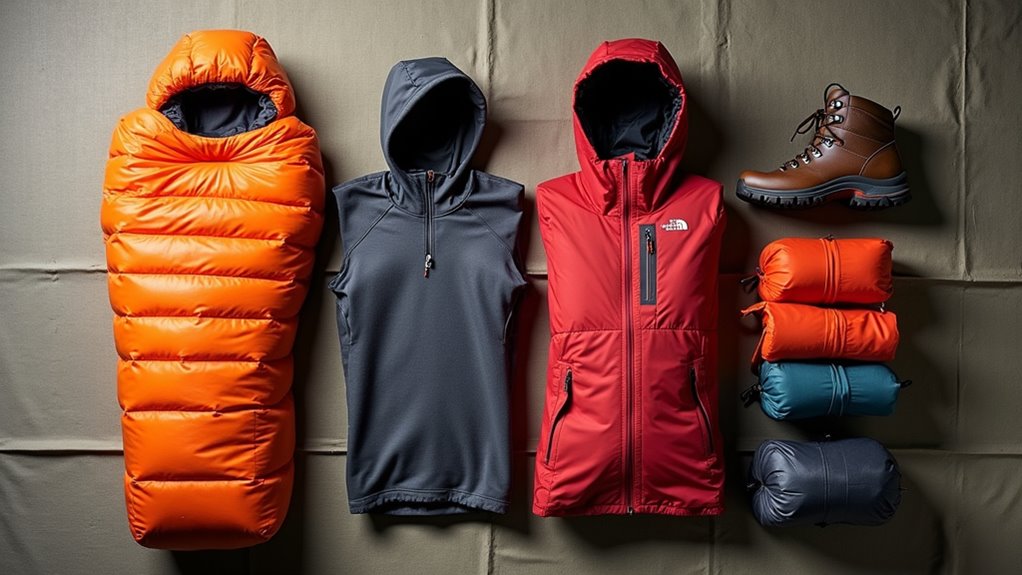
While your multi-tools handle camp tasks, smart clothing choices become your first line of defense against the elements. You’ll want a reliable layering system that adapts to changing conditions without breaking your budget.
Start with moisture-wicking base layers that pull sweat away from your skin. Skip expensive merino wool if funds are tight—synthetic fabrics work nearly as well for half the cost.
Add an insulating mid-layer like fleece or down, depending on your climate needs.
Your outer shell should be waterproof yet breathable. Don’t forget a quality rain poncho that doubles as a tarp.
Pack extra socks and underwear—wet feet ruin trips fast.
A warm beanie and waterproof gloves complete your weather protection arsenal without requiring a second mortgage.
When camping in tropical destinations, consider how local climate patterns might require adjustments to your standard layering approach.
Beyond keeping warm and dry, you’ll need supplies to handle medical emergencies and unexpected situations in the wilderness. A well-stocked first aid kit can mean the difference between a minor setback and a trip-ending disaster.
Don’t break the bank building your emergency kit. Start with basics and add items based on your group’s specific needs and medical conditions. Many dollar stores carry essential supplies at a fraction of outdoor retailer prices.
Essential first aid and emergency items include:
When planning your wilderness adventure, consider embracing vegan-friendly camping options that align with ethical outdoor practices while maintaining safety and preparedness.

Why rough it more than necessary when a few comfort items can transform your camping experience from endurable to enjoyable? You don’t need expensive gear to upgrade your outdoor comfort substantially.
A quality camping chair provides back support after long hiking days and beats sitting on logs or rocks. Pack a small pillow or inflatable version – your neck will thank you. Bring battery-powered lanterns instead of relying solely on flashlights; they create ambient lighting for evening activities.
Don’t forget wet wipes for quick cleanups when showers aren’t available. A portable phone charger keeps you connected for emergencies and navigation. Consider a small folding table for meal prep and games.
For truly comfortable sleeping, invest in a quality camping air bed that provides cushioning and insulation from the hard ground.
These affordable additions won’t break your budget but they’ll make your camping trip considerably more comfortable and memorable.
Smart packing can make or break your camping trip, turning chaos into organized efficiency. You’ll save time, reduce stress, and actually find what you need when you need it.
Start with compression sacks for sleeping bags and clothes – they’re game-changers for space-saving. Packing cubes keep your gear sorted and easily accessible. A dedicated camp kitchen box prevents you from digging through everything for your can opener.
These affordable solutions transform your campsite from cluttered mess to organized basecamp. Just like advanced skiers need the right equipment for challenging terrain, campers require proper organization tools to handle the demands of outdoor adventures.
You’ve got your camping essentials mapped out like a seasoned explorer charting new territory. Don’t let analysis paralysis keep you indoors—start with the basics and build your gear collection over time. Remember, even Daniel Boone didn’t have everything perfect on his first wilderness adventure. Your ideal camping setup will evolve with experience, so grab what you can afford now and hit the trail. The great outdoors won’t wait forever.